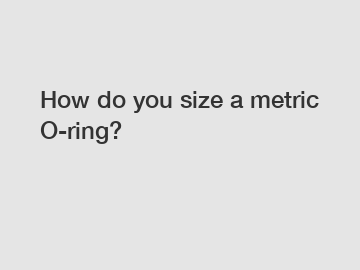How do you size a metric O-ring?
Finding the right metric O-ring size may seem daunting, especially for those new to the world of sealing technology. However, with the right knowledge and a few useful tips, you can easily navigate through the complexities of sizing metric O-rings. In this blog post, we will explore the key factors to consider when sizing a metric O-ring and empower you to make informed choices with confidence.
1. Understanding Metric O-Ring Dimensions:
Metric O-rings are specified by their inner diameter (ID), cross-sectional diameter (CS), and material thickness. The ID represents the inner circumference of the O-ring, while CS denotes the width of the O-ring material. These dimensions are measured in millimeters (mm) and are crucial in selecting the appropriate size for your application.

2. Determining O-Ring Diameter:
To correctly size a metric O-ring, the first step is to determine the required diameter. Measure the inside diameter of the groove where the O-ring will sit, and then choose an O-ring with a slightly smaller ID. This slight compression ensures a proper seal by effectively filling the gap between the surfaces. However, it's important to avoid excessive compression, which can lead to premature failure.
3. Calculating Cross-Sectional Diameter:
A metric O-ring's cross-sectional diameter is critical for ensuring optimal performance. The correct CS diameter can be determined by considering the amount of squeeze necessary for effective sealing, as well as the groove design and material characteristics. It's essential to choose an appropriate CS diameter to prevent over-compression or under-compression, which can result in leakage or inadequate sealing.
4. Material Selection:
Choosing the right O-ring material is equally important as sizing. Different operating conditions require specific materials to withstand extreme temperatures, chemicals, and pressures. Materials like silicone, nitrile rubber, Viton®, and EPDM are common choices due to their excellent sealing properties and compatibility with a wide range of applications. It's crucial to consult O-ring material compatibility charts and seek expert advice to make the optimal material selection.
5. Industry Standards and Specifications:
To ensure accuracy during the sizing process, it's important to consult industry standards and specifications. International standards such as ISO 3601, AS568, and JIS B2401 provide detailed guidelines for metric O-rings, including size tolerances, groove dimensions, and material compatibility. Adhering to these standards enhances compatibility and ease of replacement.
6. Seeking Expertise and Trustworthy Suppliers:
When it comes to sizing metric O-rings, it's essential to rely on trustworthy suppliers and seek expert guidance. Reputable suppliers with a wide range of O-ring options and technical expertise can assist in determining the correct size, material, and dimensions based on the specific requirements of your application. Their experience and knowledge elevate the trustworthiness and reliability of the guidance you receive.
7. Continuous Improvement and Burstiness:
Conclusion:
Sizing a metric O-ring requires attention to detail, a solid understanding of dimensions, material selection, and adherence to industry standards. By following the steps outlined in this guide and seeking expert advice, you can confidently select the appropriate metric O-ring size for your application. Remember that precision matters in achieving optimal sealing performance, and reliable suppliers can guide you towards long-lasting and efficient sealing solutions.
For more TC FKM rubber oil seal, End Cover Seal, NBR Rubber Oil Sealinformation, please contact us. We will provide professional answers.


